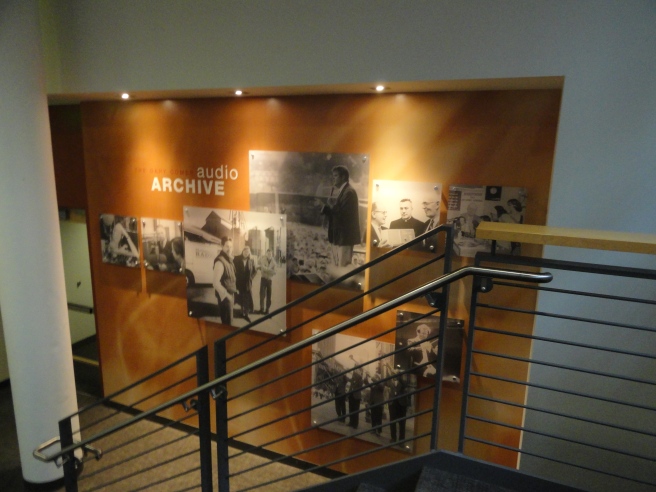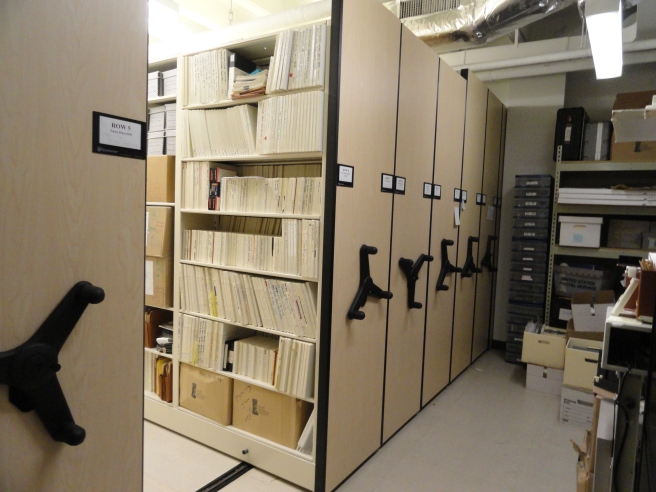Training in Boston was an exciting, fun, heady experience, but I felt a little overwhelmed by the end. How would I approach a new job coming off such a high, from a week of training?
The answer, of course, is just fine, thanks. I have the distinction of being the only resident who didn’t have to move for this project (thus the weekend after training was spent sleeping, not driving across any number of states). I grew up listening to Minnesota Public Radio, usually the classical station in my mom’s car. As an adult, I rely on MPR news, and I listen to the Current. When I’m out of state, I sometimes say I have a Wobegon accent. And when I read that they were one of the hosts for the AAPB NDSR program, I was excited; when I learned it was metadata based, I was stoked. I couldn’t have asked for a better project for the next phase of my career.

Minnesota Public Radio is a huge part of the culture in this state. It began in Collegeville, Minnesota as a classical music station in 1967, gradually adding in news as it grew. Now based in downtown St. Paul, MPR has grown into a well respected news organization, reaching over 900,000 with its three regional radio stations, MPR news, Classical MPR, and The Current.
My project is a little different than most of the other projects in this cohort. So far, I’ve been digging around in the metadata of the internal database Eddy, trying to work out how things are organized, with the goal of documentation, and with the hope of figuring out a way to normalize it going forward.
My first week I was given a project as a means of exploring, and MPR being a news organization, it was a timely one. On August 1st, 2016 (and my first day at MPR), Ojibwe author Jim Northrup passed away. Northrup was a veteran of the Vietnam War and wrote very powerfully about his experiences, and he spoke candidly about his life and his goals of using the Ojibwe language and preserving his culture, his PTSD, and of course, his writing.
I spent a good part of each day my first week digging through broadcasts featuring him, and other Native writers in Minnesota. Some of these names are familiar to me, some of these books I have read, most I haven’t. I’m always interested in what voices are heard, what stories are told. It’s nice to hear from these storytellers in their own words. I hope this is a literary tradition that will grow and become more visible.

Week two began with a deeper dive into the metadata, as well as continuing to manually transfer metadata from Eddy to the Archive portal. Yes, that’s a slow process, but it’s also been a useful training exercise, evaluating what can and cannot go on the portal, and cleaning up and normalizing the collection. Many different stakeholders feed into the Eddy database, and as a result, the metadata sometimes doesn’t all match up. Individual shows and producers have all described their productions differently, and as we talk about moving away from the current portal, we have a lot to consider about how we organize the records we share. There’s a very real human element that is constantly driving the conversation, as it’s not just the archive team creating the metadata.

In addition to transferring things to the portal, I was also tasked with creating new records in Eddy. Margaret Bresnahan, archivist and my primary mentor, led me down to the cold storage (I love cold storage) and introduced me to the masters and copies of the first two Star Wars audio plays. For those of you who don’t know, Star Wars (A New Hope), Empire Strikes Back, and Return of the Jedi were all dramatized into radio plays. MPR had a huge hand in the production of the first two, Star Wars and Empire Strikes Back (and if I may say so, those are the best two of the audio plays, sorry RotJ). Cataloging them meant doing a fair bit of research, and it was such a pleasure to spend a little time revisiting the plays. MPR does not own the rights, so they won’t be digitized, at least, not right now. But just knowing the masters are in the archive fills me with such delight. It also raised a few more metadata questions that we now have to get to the bottom of, mostly concerning how titles work in Eddy, and how something might look clean for a user, but on the backend, it’s difficult to explain to a database that the three or four title fields (“Star Wars”, “Empire Strikes Back”, “Empire Strikes Back Episode 1”, Freedom’s Winter”) are all relevant.

Right now we’re exploring making certain fields and some audio (depending on rights) available directly to the web without transferring the information to the Archive Portal. It’s been a lot of conceptual planning, throwing ideas around, trying to bring in the folks who are actually responsible for building the website.
Meanwhile, I serve on the board of my childhood library, and we’ve been planning an extensive remodel of the building. It’s been interesting to compare the process of building our ideas for Eddy to the process of working with an architect on a physical building. Weirdly, this goes hand in hand with NPR’s proposal to the AAPB, talking about metadata and digital collections in terms of physical construction. Like Eddy, with its different metadata authors, the building was constructed in 1922 and was remodeled in the 1970s. Access and design are the same issues we’re talking about with Eddy. It’s all a bit nebulous in my head right now, but I’m excited to see where this goes!
If you would like to follow my day to day ramblings, my twitter account is @libkatem. See you soon!
This post was written by Kate McManus, resident at Minnesota Public Radio.

One thought on “Metadata Practices at Minnesota Public Radio”